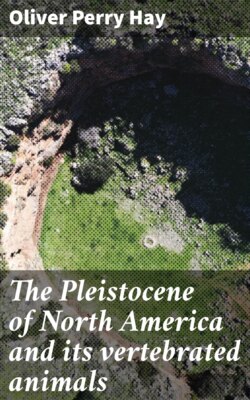Читать книгу The Pleistocene of North America and its vertebrated animals - Oliver Perry Hay - Страница 29
На сайте Литреса книга снята с продажи.
QUEBEC.
ОглавлениеTable of Contents
3. Bic, Rimouski County.—In Le Naturaliste Canadien (vol. XXXVI, 1908, p. 51), the editor, V. A. Huard, in commenting on a letter written to him and announcing the capture of a walrus somewhere on the northern coast of the Gulf of St. Lawrence, recalled an article contributed in 1869 by the former editor, a priest named Provancher (Le Naturaliste Canad., vol. II, p. 19). This writer stated that some workmen employed in the construction of the International Railway had discovered at Bic, Rimouski County, Quebec, on the southern shore of the St. Lawrence, a complete skeleton of a walrus. This skeleton had a length of 13 feet. It was found at a depth of 14 feet, in a compact clay, and at a height of more than 100 feet above sea-level. The skeleton was deposited in the museum of the Rimouski Seminary, but was destroyed in a fire in 1881.
It is evident that when that animal died and was buried in the clay the land in that region stood at a level at least 100 feet lower than at present.
Through the late Mr. L. M. Lambe, of the Canada Geological Survey, the writer has received from Mr. W. A. Johnston, who made a special study of the Pleistocene, information regarding the age of the clays at Bic. He says that little can be said definitely regarding the age of the clays in which the walrus skeleton was found. Clays belonging to the Champlain submergence stand now at an elevation of 311 feet in that vicinity; and marine shells occur in clays, supposed to belong to the Champlain, at an altitude of 120 feet. There is a possibility that some of the clays in that region are earlier than the time of the Wisconsin. Mr. Johnston cites Guide Book No. 1, part I, pp. 77–78, of the Canada Survey, and Dawson’s Ice Age, 1893, pp. 186–195. The first article was written by J. W. Goldthwait. On page 921 of Logan’s Geology of Canada, 1863, it is stated that bones of whales and of the morse have been found partially embedded in the Leda clay in several places between Bic and Matanne, about 60 miles farther down the river.
4. Montreal, Quebec.—In 1863, Logan (Geol. Surv. Canada, p. 920) told of the discovery of a skeleton of Phoca grœndlandica near Montreal. The exact locality appears to be about 0.75 mile east of what was then known as the Mile-end quarries. These quarries were about 100 feet above sea-level, and the spot where the skeleton was found was about 40 feet lower down. At a nearby brickyard some bones of a young seal were discovered which belonged probably to the same species. One of the pelvic bones of a seal was found also at the Mile-end quarries. Dr. J. W. Dawson (“Canadian Ice Age,” 1844, p. 267) stated that the skeleton was found in the Leda clay; that it is in the collection of the Geological Survey, at Ottawa; and that detached bones are in the Peter Redpath Museum of McGill University at Montreal. The Leda clay, at least that of the upper portion of the St. Lawrence Valley, is now referred to the Champlain epoch, a time when the sea had invaded this valley and even Lake Ontario.
5. Tétreauville, Ottawa County.—In 1897 H. M. Ami (Ottawa Naturalist, vol. XI, p. 24) announced that he and Ruggles Wright had found some bones which were probably those of a young harbor seal, Phoca vitulina. They were collected in 1888, in a sandy layer about 30 feet below the surface, on a hillside, at Wright’s brick clay pits, on Aylmer Road, Tétreauville, Quebec. This place is about 5 miles west of Hull, and within 10 miles of Ottawa. These bones are in the Victoria Museum at Ottawa. Besides the left half of the lower jaw with teeth, there are both ear-bones, one exoccipital, the greater portion of the backbone, scapula, part of the pelvis, and some of the larger limb-bones. This species is abundant in the Gulf of St. Lawrence, and also ascends the larger rivers to a great distance. Doubtless great numbers inhabited the inland sea which, during Champlain times, is believed to have occupied the valley of the St. Lawrence, Lake Ontario, and the valley of the Ottawa River nearly as far up as the city of Ottawa.
